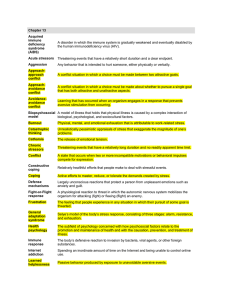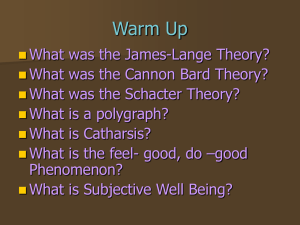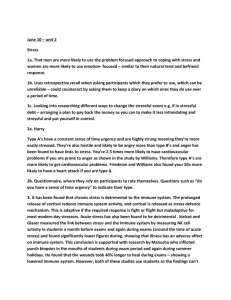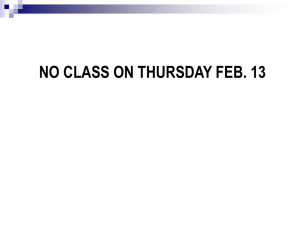Chapter 14 pt. 1: Stress and Health
advertisement
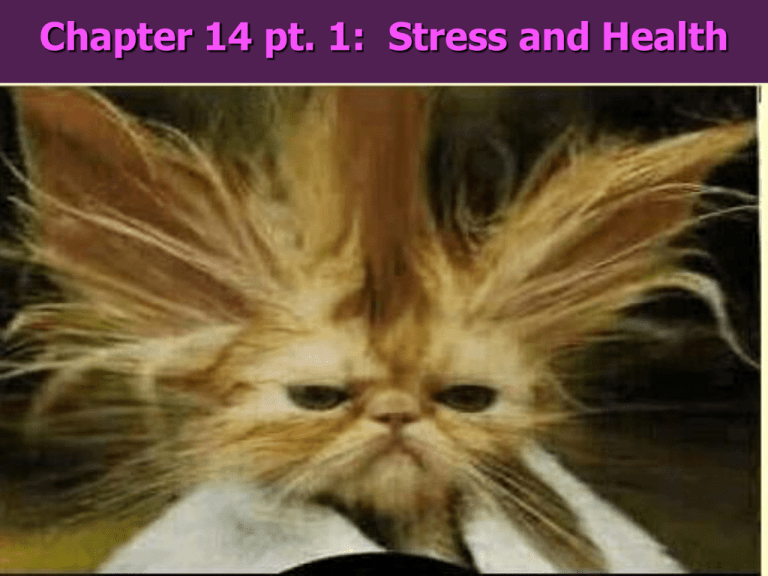
Chapter 14 pt. 1: Stress and Health Bellringer Fill out the survey and find out if your stressed. On the back write out the things that stress you out the most. Then think about ways you can cope with your stress or lessen it. Agenda (Note: Beginning of Unit 12, another short one) 1. Bell Ringer: What causes stress? (5) 2. Notes: Stress and Health Pt. 1(20) 3. Bullying article and discussion (10) 4. Stress activity (20) 5. Video Clip: Getting into college discussion (15) Studying the Effects of Stress on Health Behavioral Medicine: field that combines knowledge of biomedical perspective and behavioral perspective to study and treat health and illness. Term is often used interchangeably with Psychiatry. Health Psychology: subfield of psychology that is used to contribute to behavioral medicine. Looks at psychological causes of illness and stress (cognitive, environment, social, biological, etc.) Killers of Yesterday and Today Percentage U.S.deaths 30 Percentage U.S.deaths 30 20 20 10 10 0 0 Tuber- Pneu- Diarrhea/ Heart culosis monia enteritis disease 1900 Heart Cancer Strokes Chronic disease lung disease 1991 What is Stress? Stress is the process by which we respond to events, that we appraise as threatening or challenging. Stressors: are the events/things that stress us out! Stress Is Not Caused By An Event Itself! Cognition affects how we react and appraise an external event which affects how we respond. Stressors Catastrophes Life changes Hassles Intervening factors Appraisal Perceived control Personality Social support Coping behaviors Stress reactions Physiological Emotional Behavioral Stress Can Be Harmful or Helpful Depending on Your Appraisal Appraisal Response Threat (“Yikes! This is beyond me!”) Panic, freeze up Challenge (“I’ve got to apply all I know”) Aroused, focused Stressful event (tough math test) Yerkes-Dodson Principle of Arousal (Remember?) Yerkes-Dodson Principle of Arousal: general tasks are performed best with a medium amount of stress/arousal. Biology of Stress? What is Activated When You Feel Stress? Stress-Response Cycle Includes: – 1. Sympathetic and parasympathetic cycles are activated – 2. Withdraw. Pull Back. Conserve Energy. – 3. Women- “Tend and Befriend” Secondary Response Cycle Animals and Humans Tend to React To Stress In the Same Pattern. Hans Selye discovered the responsive cycle for how we react to stress which he named the: General Adaptation Syndrome (GAS) – Phase 1: Alarm: activation of sympathetic nervous system. (“Fight or Flight”) – Phase 2: Resistance: arousal remains high as you attempt to cope with the stressor. – Phase 3: Exhaustion: body becomes run down with constant stress which can leave you more vulnerable to illness or even death. Diagram of GAS The body’s resistance to stress can only Last so long before exhaustion sets in Stress resistance Stressor occurs Phase 1 Alarm reaction (mobilize resources) Phase 2 Resistance (cope with stressor) Phase 3 Exhaustion (reserves depleted) Stressful Life Events Can Create Serious Health Risks Categories of Stressful Life Events: – 1. Catastrophes: unavoidable natural disasters, etc. – 2. Significant Life Changes: loss of loved one, leaving home, loss of job, etc. – 3. Everyday Hassles: traffic, long lines at Best Buy, etc. Perceived Control Effects Health and Stress Stressful events are especially harmful if they are perceived as negative and uncontrollable. Those who feel stressful events are beyond their control are also more susceptible to illness and disease. The Rat With No Control Over the Shocks Develops Ulcers “Executive” rat To shock control “Subordinate” rat To shock source Control rat No connection to shock source Other Influences on Health and Stress Poverty: poorer people are more at risk for a premature death. Inequality: areas where there is a large discrepancy/gap between rich and poor have lower life expectancies than areas where differences are less extreme. Other Influences on Health and Stress Optimism-Pessimism: Those with more positive outlooks tend to cope with stressful events better and have better health than those who dwell on the negative. Outlooks often tied to feelings of control. Persistent Day to Day Stress May Lead to Burnout Burnout: physical, emotional, and mental exhaustion brought on by persistent job-related stress. Often common in teachers, nurses, and police officers. Stress and Heart Disease Although relatively rare in 1900, by the 1950s coronary heart disease has become the leading cause of death in America. Coronary Heart Disease: when vessels of heart are clogged which stops heart muscles from being nourished. Many behavioral factors help contribute to this disease but stress is also a major factor. Hopelessness and Heart Disease Hopelessness scores 3.5 3 2.5 Men who feel extreme hopelessness are at greater risk for heart attacks and early death 2 1.5 1 0.5 0 Heart attack Low risk Death Moderate risk High risk Personality Type and Heart Disease Type A Personality: competitive, hard driving, impatient, verbally aggressive, and anger prone people. Type B Personality: easy-going and relaxed people. Who’s at greater risk for heart disease? Stress Related Illnesses Psychophysiological Illnesses: “mind-body” illnesses. Physical illnesses caused by stress. –Ex: Hypertension and some headaches. Blood pressure also increased by too much stress. Are also referred to as Psychosomatic disorders. Somatoform Disorders (Not In Book) Somatoform Disorder: illnesses where you have some physical symptoms without an apparent physical cause. Illnesses are said to be psychological in nature. Theories about causes of somatoform disorders are often rooted in psychoanalytic theory. Illnesses are often referred to as “Hysteria.” Examples of Somatoform Disorders Conversion: when a person converts intense emotional difficulties into the loss of a specific physiological function. – Ex: blindness or paralysis without a physical cause. Symptoms often have sudden onsets, terminations, and reappearances. Behavior is unintentional and outside of the conscious control of the patient. Cortisol The Stress Hormone: secreted at higher levels during “fight or flight.” – Increases in times of stress give your body the energy to survive. Too much over time and it can have a negative impact on your health. Examples of Somatoform Disorders Hypochondriasis: is when a healthy person becomes preoccupied with imaginary ailments. Person is genuinely convinced they are ill. Often associated with OCD and anxiety disorders Examples of Somatoform Disorders Factitious Disorder: an illness whose symptoms are either self-induced or falsified by the patient. Sometimes patients lie about disorder to get attention or sympathy; others are often interested in receiving drugs Factitious or other benefits associated Ulcer with the feigned illness. The Immune System and Stress Lymphocytes: Main defender against disease in immune system made up of two types of white blood cells. B lymphocytes form in the bone marrow and release antibodies that fight bacterial infections T lymphocytes form in the thymus and, among other duties, attack cancer cells, viruses and foreign substances Fighting Disease with Immune System Macrophage: other agent of immune system which identifies, pursues, and ingests harmful invaders. Problems with Immune System Immune System can either react too strongly or under react to harmful bodies. – Over-reaction causes body to attack its own tissues. Ex: arthritis, allergies, lupus, M.S. – Under-reaction causes harmful bodies to spread. Ex: cancer Stress can divert energy away from the immune system making illnesses more likely. Conditioning the Immune System Experiments UCS (drug) UCR (immune suppression) CS (sweetened water) CS (sweetened water) UCS (drug) UCR (immune suppression) CR (immune suppression) have been conducted illustrating power to condition the immune system to respond in certain ways. Promoting Health- Coping with Stress Aerobic Exercise has positive psychological and physical benefits. Increases heart and lung fitness and may also help alleviate depression and anxiety. Depression 14 score 13 No-treatment group 12 11 10 Relaxation treatment group 9 8 7 6 Aerobic exercise group 5 4 3 Before treatmentAfter treatment evaluation evaluation Using Biofeedback to Improve Health Biofeedback: system for electronically recording, amplifying, and feeding back information regarding a subtle physiological state like blood pressure and muscle tension. Promoting Health A strong social network which offers support strongly promotes health during an illness and when healthy. % with high support Promoting Health Spirituality and Faith Communities has a strong correlation with positive health and enhancing medical treatment. Possible reasons behind correlation with religion? Overview of Healthy and Unhealthy Tendencies Life events Personal appraisal Challenge Threat Personality type Hostile Depressed Pessimistic Easy going Nondepressed Optimistic Personality habits Nonsmoking Regular exercise Good nutrition Smoking Sedentary Poor nutrition Level of social support Close, enduring Lacking Tendency toward Health Illness

